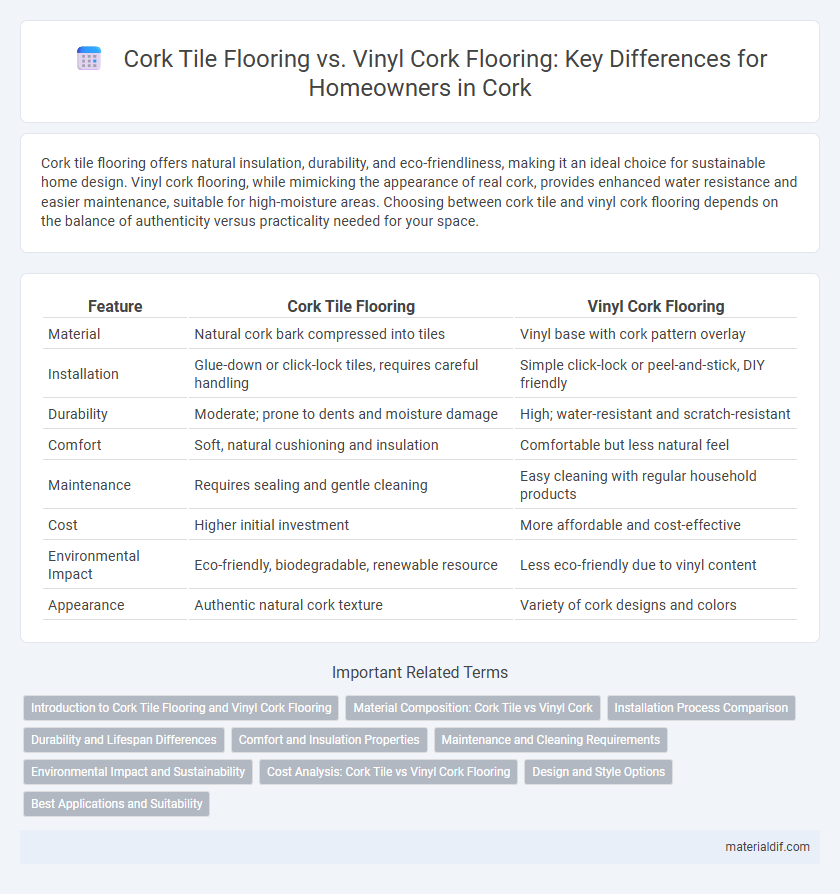Cork tile flooring offers natural insulation, durability, and eco-friendliness, making it an ideal choice for sustainable home design. Vinyl cork flooring, while mimicking the appearance of real cork, provides enhanced water resistance and easier maintenance, suitable for high-moisture areas. Choosing between cork tile and vinyl cork flooring depends on the balance of authenticity versus practicality needed for your space.
Table of Comparison
| Feature | Cork Tile Flooring | Vinyl Cork Flooring |
|---|---|---|
| Material | Natural cork bark compressed into tiles | Vinyl base with cork pattern overlay |
| Installation | Glue-down or click-lock tiles, requires careful handling | Simple click-lock or peel-and-stick, DIY friendly |
| Durability | Moderate; prone to dents and moisture damage | High; water-resistant and scratch-resistant |
| Comfort | Soft, natural cushioning and insulation | Comfortable but less natural feel |
| Maintenance | Requires sealing and gentle cleaning | Easy cleaning with regular household products |
| Cost | Higher initial investment | More affordable and cost-effective |
| Environmental Impact | Eco-friendly, biodegradable, renewable resource | Less eco-friendly due to vinyl content |
| Appearance | Authentic natural cork texture | Variety of cork designs and colors |
Introduction to Cork Tile Flooring and Vinyl Cork Flooring
Cork tile flooring is made from compressed cork granules bound with resin, offering natural insulation, durability, and a unique textured appearance suitable for eco-friendly interiors. Vinyl cork flooring combines the aesthetic appeal of natural cork with the resilience and water resistance of vinyl, making it ideal for high-traffic and moisture-prone areas. Both options provide sustainable flooring solutions, but cork tiles excel in breathability and comfort while vinyl cork flooring emphasizes easy maintenance and enhanced durability.
Material Composition: Cork Tile vs Vinyl Cork
Cork tile flooring is composed of natural cork granules compressed and bonded with resin, creating an eco-friendly, renewable material with excellent thermal and acoustic insulation properties. Vinyl cork flooring combines a cork layer with a vinyl backing, enhancing durability and water resistance while maintaining some of cork's natural comfort and insulation benefits. The choice between these materials depends on priorities like sustainability, moisture tolerance, and maintenance requirements within Cork's climate.
Installation Process Comparison
Cork tile flooring installation involves fitting pre-cut tiles into a subfloor, requiring precise alignment and adhesive application for a durable bond. Vinyl cork flooring offers a simpler installation with click-lock planks or adhesive backing, allowing faster, DIY-friendly placement over various subfloors. Both require moisture barriers in damp areas, but vinyl cork's flexibility and thinner profile provide easier handling and quicker setup compared to traditional cork tile.
Durability and Lifespan Differences
Cork tile flooring offers superior durability with a lifespan of up to 25 years when properly maintained, thanks to its dense composition and natural resistance to wear. Vinyl cork flooring, while more affordable, typically lasts 10 to 15 years but provides enhanced water resistance and easier maintenance. Choosing cork tile flooring is ideal for long-term durability, whereas vinyl cork flooring suits areas with high moisture exposure and budget constraints.
Comfort and Insulation Properties
Cork tile flooring offers superior natural insulation and sound absorption due to its dense cellular structure, providing enhanced comfort underfoot and better thermal regulation compared to vinyl cork flooring. Vinyl cork flooring mimics the appearance of cork but lacks the same cushioning effect and thermal insulation, often resulting in a harder, less comfortable surface. The inherent elasticity and breathability of natural cork tiles create a warmer, quieter floor environment ideal for residential spaces.
Maintenance and Cleaning Requirements
Cork tile flooring requires regular sealing and gentle cleaning with pH-neutral cleaners to maintain its durability and prevent water damage, while vinyl cork flooring offers superior water resistance and can be easily cleaned with standard household detergents. Vinyl cork flooring demands less maintenance, as it is less prone to scratches and stains, making it ideal for high-traffic areas. Both options benefit from prompt spill cleanup to preserve their appearance and longevity.
Environmental Impact and Sustainability
Cork tile flooring originates from the natural bark of cork oak trees, making it a highly renewable and biodegradable material that supports forest preservation and carbon sequestration. Vinyl cork flooring, while mimicking the aesthetic, consists largely of synthetic materials derived from petrochemicals, resulting in higher carbon emissions and limited recyclability. Choosing cork tile flooring promotes sustainable practices by reducing environmental impact through its natural composition and lower lifecycle footprint.
Cost Analysis: Cork Tile vs Vinyl Cork Flooring
Cork tile flooring typically costs between $3 to $7 per square foot, while vinyl cork flooring ranges from $2 to $5 per square foot, making vinyl cork a more budget-friendly option. Installation expenses for cork tiles can average $4 to $8 per square foot due to the need for adhesives and precise placement, whereas vinyl cork often features a click-lock system or peel-and-stick backing, reducing labor costs. Long-term maintenance costs favor cork tile, which may require resealing every few years, while vinyl cork flooring demands less upkeep but may have a shorter lifespan, affecting overall value.
Design and Style Options
Cork tile flooring offers a natural, warm aesthetic with varied patterns and textures that enhance traditional and rustic interior designs. Vinyl cork flooring provides a broader range of color palettes and finishes, including glossy and matte options, suitable for modern and contemporary styles. Both flooring types support eco-friendly design trends but differ in surface customization and visual versatility.
Best Applications and Suitability
Cork tile flooring offers superior durability and moisture resistance, making it ideal for kitchens, bathrooms, and high-traffic areas, while providing excellent sound insulation and thermal comfort. Vinyl cork flooring is more affordable and easier to install, suited for rooms with less foot traffic such as bedrooms or home offices, but it lacks the natural breathability and eco-friendliness of genuine cork tiles. For homeowners prioritizing sustainability and longevity, cork tile flooring is the best application, whereas vinyl cork flooring suits budget-conscious projects requiring quick installation.
Cork Tile Flooring vs Vinyl Cork Flooring Infographic

 materialdif.com
materialdif.com